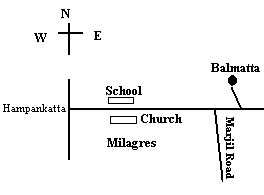

Milagres Church is close by to Hampankatta, which is the central commercial area of Mangalore. In 1934 when I was born it was very quiet and the Church was the central focus of Catholics. The first church had come up nearly 450 years ago, but the Church which one sees, was built around 1920.
In front of the Church there was a huge compound, and on the sides, there were houses of the Saldanha family. One of their houses was rented by the Catholic Bank founded by my grandfather, Mr. John Manuel Castelino, who was then the headmaster of Milagres School, were he continued in that position for 50 years. The Bank building had an upper story, which were the quarters of the Secretary, the post held by Mr. Castelino. His eldest daughter Stella, had come for confinement, and one week before Christmas she got labor pains and the doctor was summoned, and I was born. The next day they baptized me and in the same Church, I had my First Communion, and Confirmation.
My paternal grandfather was a coffee planter and he built his house in Balmatta, which in 1934 was sold to one of my father's cousins, as our family faced the effects of the US depression, and lost export potential. Our properties were auctioned as a result. In 1945 the ancestral house was sold to a gentleman, who later sold it to a convent. Today, the Nazareth Convent stands in its place, and the only place of the old home was the living room, which was converted into a Chapel. My mother spent some of her last days in this convent, which provided a boarding for old people.
From 1940 I was enrolled in the Milagres School, which had classes up to 8th Standard. In those days, the classes after 5th Class were called "Forms" So it was I, II and III Form. After I finished III Form, I went to St. Aloysius College on the Balmattta Hill and completed my Matriculation over there.
The first tarred roads came to Mangalore in 1947. Before that the municipality used to send water tankers, which used to sprinkle water on the graveled roads. As most of us walked bare foot, it was very painful after the roads were tarred, especially in summer, and we used to run on our tip toes.
Our external influences came mostly from our homes, school and the Church, as there were no radio stations or newspapers and magazines at our disposal. So we grew in innocence. After we finished schooling and began to work, the Country's media developed and external intellectual influences started to take over the traditional sources which have been primarily responsible to today's state of affairs. Yet most of the families have preserved tradition and the children too, though externally appear to be modern, are deep within conservative.
Around 1950 many youngsters migrated to other countries for work, and their income increased the wealth of their families in Mangalore. Many sold their houses and moved to Bangalore, which was a more modern town that Mangalore. Others left to live in other countries and became citizens of these countries. Today Mangaloreans can be found all over the world.
The influences of the Western world, where many families migrated have made the outlook of the young Mangaloreans more open. As age takes over, nostalgia comes as a corollary. Just as I reminisce the past, they too tend to do the same. Perhaps this effort on my part could help the new generation to appreciate their past heritage and attempt to learn more about it.